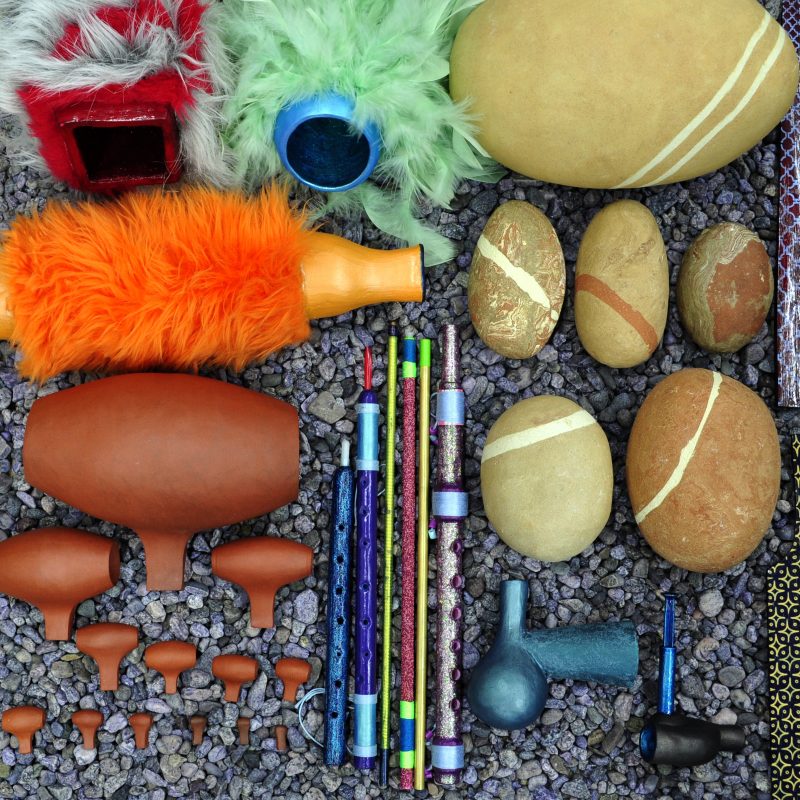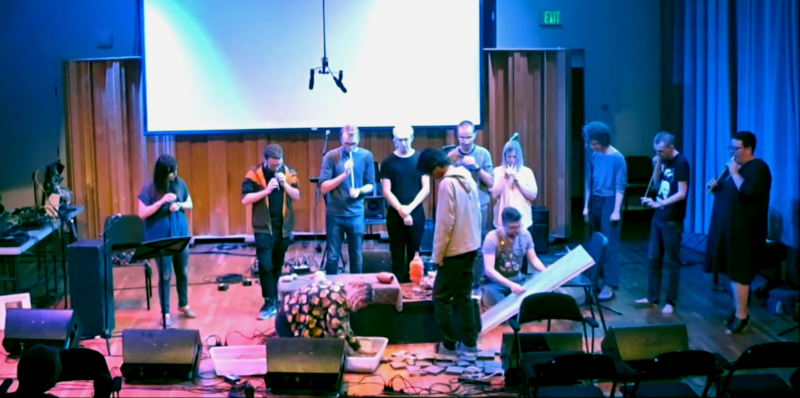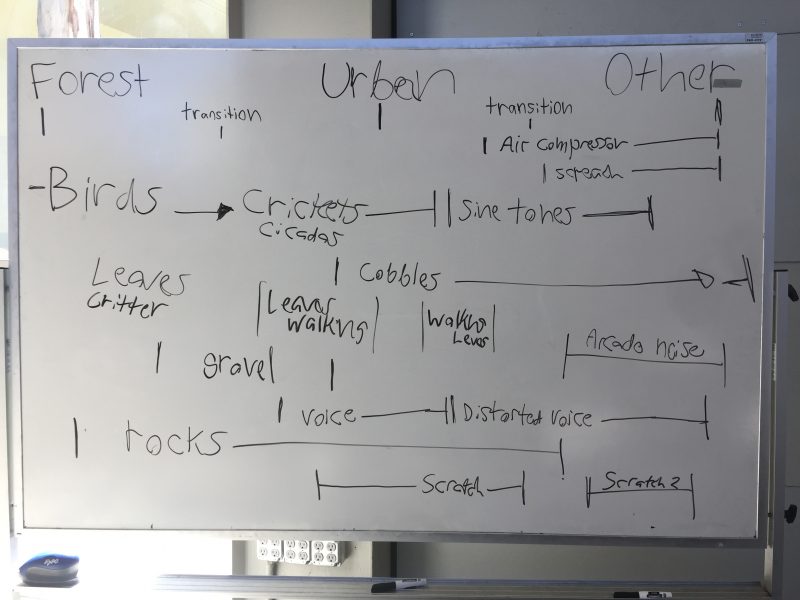THE EARTH ORCHESTRA
The Earth Orchestra is an ensemble populated with unusual musical instruments that are a mix of found objects and instruments of my own construction. The goal of this orchestra is to expand and explore recreating sounds of the naturalistic landscape. These sounds are not limited to things like bird, leaves, and wind, noises we commonly hear in the human constructed landscape are also emphasized. These sounds are made using physical acoustic instruments. Included in the ensemble are the microtonal ocarinas, river rocks, turbulence flutes and screamer tubes. The sound profile of the orchestra can range from haunting and melodic to absurd and cacophonous. The scores for the Earth Orchestra are designed to be open ended and collaborative. Each score sets up a playing field where there are many options for the way that players and the ensemble as a whole can progress through a piece. Players decide the profile of their sound based off of comparisons of roles in an ecosystem and can perform in a variety of ways as long as the overall structure of the piece is followed. An example would be to “Play the sounds of a bird.”, the player is able to make decisions of what that sounds like and the instrument they want to use to make that sound. The ensemble is able to reciprocate and adjust as each player develops their role in a piece, creating a sort of sound based ecosystem in the process. The Earth Orchestra does not require dedicated musicians to each instrument, the majority of parts are intuitive and can be easily learned in a short rehearsal setting.
The main project the Earth Orchestra has performed is called Forest|Urban|Other. The score explores ways of making a shifting landscape that changed from naturalistic to human made to an imagined future that can be either, both, or something else entirely. Prototypes of this score have been performed as part of the Experimental Music Workshop at CalArts as well as ESP Night.
SCORES
Recorded as part of the Spring 2018 Experimental Music Workshop at CalArts.
Ensemble members for 2018 included- Michael Pisaro-Liu, Lilac Atassi, Brandon Chang, Michael DeMaio, M Denney, Jasna Duran, Kevin Good, Wesley Hicks, Michael Janz, Greta Melcher, Cherlyn Hsing-Hsin Liu, John Pisaro, Cody Putman, Sivan Silver-Swartz, Mari Garrett, Julius Tedaldi, Jeremy Parel.
Not all ensemble members are present in the recording.
FOREST|URBAN|OTHER
For 8 or more people.
For a duration that is longer then 5 minutes, choice at 12 minutes, try for less then an hour.
This piece requires musical instruments from the Earth Orchestra. The following instruments need to be
presented as options but no one instrument in specific is required-
Cobblestones, Gravel, and Leaves
River rocks
Microtonal ocarinas (birds, crickets, electronic noises)
Voice and distorted voice
A large and small scratch board
Instruments that sound like various animals (a screeching bird, a big cat, and a cow)
Wind instruments (ones that sound like wind)
Instruments that sound like arcade noise, dial up, air compressor, and screeching
Introduction-
These instruments are to be introduced to the players, allowing them to hear various sounds the instruments
make. The players are to then select instruments they want to play on (no experience is needed, each
instrument is easy to learn how to play and a vocabulary of sounds can be developed in under 5 minutes.)
Each player spends about 5 minutes playing on the instruments, learning how it works and deciding the
kinds of sounds they would like to make.
Building the Score-
This piece is broken up into 3 landscapes- Forest, Urban, and Other. There is a transition in between each
where sounds will slowly change between the two adjacent landscapes. These landscapes determine the
types of instruments that are active. Each player selects when they want to play their instrument depending
on how well the instruments sounds fits into the three acoustic landscapes. Choices of how and when to play
are also made by the players in context to one another. This makes the performance a kind of interaction
or theater between the instruments being played. Players are acting as the animals, forces, and objects
they represent. For example when one is playing a bird certain sounds will cause them to quite down for a
short period and reemerge with sound and certain other sounds will cause them to increase activity. A type
of action and response, behavior, attitude, timing, and context can be built intuitively between players. As
these things are being decided, write out a score deciding when each instrument is used. This activity should
be done as a group. Parts can be titled based off of sounds that the instrument is reminiscent of (like birds,
crickets, wind, screeching, air compressor, industrial sounds, ect.) Instruments that make a variety of sounds
can be used for more then one part. Setting up the score in a way that is easily visible such as a whiteboard
is helpful. Once the score is set, the piece is ready to perform.
Performance-
This piece can be performed in several ways. The performance can include both the Introduction and
Building the Score, or it can be just the performance based off the score. The performance can also be
unrehearsed with all activities as one continuous performance. If the performance in rehearsed beforehand,
please do not include a performative version of the Introduction and Building the Score segments. If the
score can be shown in an easily visible way please include it in the performance for the audience to see.



Here are two videos demonstrations of instruments used in the Earth Orchestra. Not featured in these videos are the Microtonal ocarinas, River Rocks, the Scratch Boards, or the Cobblestones, Gravel, and Leaves